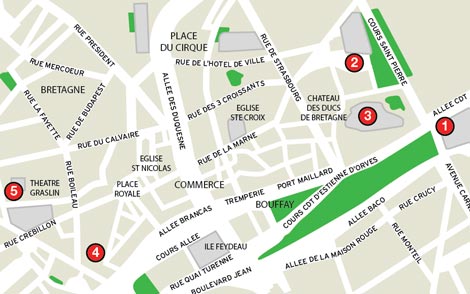From historic brasseries to unique shopping, Jenny Southan discovers what the French city on the Loire has to offer.

1. Le Lieu Unique
A good place to start your walking tour of Nantes, a city located on the Loire River in western France, is at one of its most iconic landmarks – Le Lieu Unique, near the SNCF station and Canal St Félix. The building used to be a factory owned by husband and wife team Jean-Romain Lefèvre and Pauline Utile, who were responsible for one of France’s most familiar brands, LU biscuits. If you have ever been in a French supermarket then you are bound to have come across packets of these “chic little biscuits” in varieties from Pims jam to chocolate Petit Ecolier. They first came into production here in 1846.
Since its conversion from factory to tourist attraction – the building now houses a bar, restaurant, boutique and hammam – visitors can gain access to the iconic tower. Open to the public since 2004, La Tour Lu offers a great opportunity to take in the city from an elevated perspective – for €2, you can ascend the 136 steps to the top. (Open Tues-Sat 1pm-7pm, Sun 3pm-7pm.) Restaurant Le Lieu Unique (2 Rue de la Biscuiterie, lelieuunique.com) is open for lunch Mon-Sat 12pm-2pm, and dinner Tues-Thurs 7pm-11pm, Fri-Sat 7pm-12am.
2. Cathedral of St Peter and St Paul
Take a short stroll up Cours Saint Pierre and on your left you will see the Cathedral of St Peter and St Paul. Nantes was once a medieval walled city, and just behind this place of worship is the last remaining section of it – an old gateway with white doves nestled in the brickwork. The grand Gothic cathedral took almost 500 years to complete, and beyond the striking limestone and granite façade you will find two original solid oak doors, studded with metal bolts, dating back to 1491.
After the roof of the cathedral caught fire in 1972, the interior was completely restored – in fact, much of the damage was caused by the water used to put it out. Look around and you will see a number of modern stained glass windows set into the white stone walls, a huge organ and the tomb of Francis II of Brittany and Marguerite de Foix, the parents of Anne of Brittany. This pale marble repository is an excellent example of both Gothic and Renaissance styles, and the two carved bodies lying side by side are surrounded by allegorical figures representing the cardinal virtues. Temperance, for example, holds a clock (pertaining to the passing of time) and a bridle (to control the passions). Prudence, on the other hand, is a beautiful woman but with the face of an old wise man on the back of her head to remind us that we should always think carefully about the decisions we make.
3. Nantes History Museum
A two-minute walk down the cobbled Rue Mathelin-Rodier will bring you to the Castle of the Dukes of Brittany. Along with restored ramparts (free to walk around), 500 metres of curtain walls, an open courtyard and a dried-up moat, you’ll find Nantes History Museum here, housed in the gleaming and recently renovated 15th-century Ducal Palace. The museum has more than 30 rooms and 850 objects on display, and is a fascinating way to get a better understanding of the city’s past. The permanent collection of artefacts, along with a wealth of interactive and multimedia installations, tells the story of how Nantes has changed socially, geographically, economically and culturally over the centuries.
Of particular interest is the section on the slave trade, which Nantes relied heavily on during the 18th century. This is an element of the city’s past that its residents aren’t proud of, but one that is key to understanding how Nantes became so wealthy and why the port was one of the most important in France. The museum displays logs of African people and what they were sold for during this period, journals, maps, drawings and diagrams of slave ships, and even rusty shackles that were once worn by “human cargo”. Opening times vary – visit chateau-nantes.fr for more information. Entry €5, audio guides €3.
4. Passage Pommeraye
From the castle, meander through the streets of the old town to Passage Pommeraye – a triple-tiered shopping arcade dating back to 1843. An elegant central staircase with wrought iron banisters leads up to the upper galleries and an attractive glass roof keeps the rain off. With an array of classy boutiques, independent clothes stores and chocolate shops, it’s great place to grab a couple of souvenirs to take home. If you want to taste some local treats, look out for berlingots – colourful, pyramid-shaped boiled sweets – and salted butter caramels. Visit passagepommeraye.fr
5. Place Graslin
To complete your tour, walk up the stairs and out on to Rue Santueil, which leads to Rue Crébillion, another shopping heaven to lead you into temptation. Browse if you have time, then turn right into Place Graslin, a semi-circular piazza – here you’ll find Le Moliere, said to be the oldest coffee shop in the city, Théâtre Graslin, and La Cigale, a chic brasserie known for its highly decorative interiors. It’s open for breakfast (from 7am), brunch, lunch and dinner, and offers a decent choice of set menus and à la carte cuisine. Visit lacigale.com or call +33 251 849 494 to make a reservation.
Thumbnail image © Gaël Arnaud - OTNM








